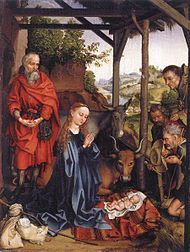Martin Schongauer

Martin Schongauer (c. 1445, Colmar – 2 February 1491, Breisach), known in Italy as Bel Martino or Martino d'Anversa, was a German engraver and painter. He was the most important German printmaker before Albrecht Dürer.
Biography

Schongauer was born in about 1440 in Colmar, Alsace, probably the third of the four sons of Caspar Schongauer, a goldsmith from Augsburg who taught his son the art of engraving.[1] Colmar is now in France but was then part of the Holy Roman Empire. He may well have been trained by Master E. S. The art historian A. Hyatt Mayor saw both their individual styles in different parts of a single engraving, and all the works with Schongauer's M†S monogram show a fully developed style. Schongauer established at Colmar a very important school of engraving, out of which grew the "Little Masters" of the succeeding generation, and a large group of Nuremberg artists.
Paintings

As a painter, Schongauer was a follower of the Flemish artist Rogier van der Weyden, and his rare existing pictures closely resemble, both in splendour of color and exquisite minuteness of execution, the best works of his contemporaries in Flanders.
Only a few of his paintings survive, the most notable of them being the Madonna in the Rose Garden, painted for St Martin's Church, Colmar.[1] The Musée d´Unterlinden in Colmar possesses eleven panels by him or his workshop, and a small panel of David with Goliath's Head in Munich is attributed to him. The miniature painting of the Death of the Virgin in the National Gallery, London is probably the work of a pupil.
Engravings

The main work of Schongauer's life was the production of a large number of beautiful engravings, which were largely sold, not only in Germany, but also in Italy and even in England and Spain. Vasari says that Michelangelo copied one of his engravings, in the Trial of Saint Anthony. His style shows no trace of Italian influence, but a very clear and organised Gothic.
His subjects are mainly religious, but include comic scenes of ordinary life such as the Peasant family going to market or the Two apprentices fighting. One hundred and sixteen engravings are generally recognised as by his hand, and since several are only known from a single impression, there were probably others that are now lost. Many of his pupils' plates as well as his own are signed, M†S, as are many copies probably by artists with no connection to him.
Among the most renowned of Schongauer's engravings are the series of the Passion and the Death and Coronation of the Virgin, and the series of the Wise and Foolish Virgins. All are remarkable for their miniature-like treatment, their brilliant touch, and their chromatic force. Some, such as the Death of the Virgin and the Adoration of the Magi are richly-filled compositions of many figures, treated with much largeness of style in spite of their minute scale.
He established the system of depicting volume by means of cross-hatching (lines in two directions) which was further developed by Dürer, and was the first engraver to curve parallel lines, probably by rotating the plate against a steady burin. He also developed a burin technique producing deeper lines on the plate, which meant that more impressions could be taken before the plate became worn.
According to Arthur Mayger Hind, Schongauer was one of the first German engravers to "rise above the Gothic limitations both of setting and type" and that he "actualises an idea of beauty which in its nearer approach to more absolute ideals appeals to a far more universal appreciation" than earlier engravers such as Master E. S..[2]
The British Museum and other major print rooms possess fine collections of Schongauer's prints.
Selected works
- Selected paintings
-
Madonna, Angel and Child
-
Mary, detai, Orlier altarpiece
-
Adoration by the Shepherds
-
Orlier altarpiece
-
Noli me tangere (detail)
-
The Virgin and Child in a Garden
-
Portrait of a young woman, c. 1478
- Selected engravings
-
Angel of annunciation
-
Griffin
-
St.Michael
-
Crucifixion by Schongauer.
-
Ecce Homo, engraving from the Passion series by Martin Schongauer
-
The Fifth Foolish Virgin
-
Standing Madonna with apple
-
The Fifth Wise Virgin
-
St. Martin
-
Christus at the Olive Mountain
-
File:Schongauer, Martin - St Antonius - hi res.jpg
-
John of Patmos
-
The First Foolish Virgin
Notes

This article includes a list of general references, but it lacks sufficient corresponding inline citations. (January 2013) |
- ^ a b Fifteenth to Eighteenth Century European Drawings in the Robert Lehman Collection. Central Europe, The Netherlands, France, England. New York: Metropolitan Museum of Art. 1999. p. 21.
- ^ Hind, Arthur M. A History of Engraving & Etching From the 15th Century to the Year 1914. Dover Publications. pp. 28–29. ISBN 9780486209548. Retrieved 3 July 2014.
References
- A. Hyatt Mayor, Prints and People, Metropolitan Museum of Art/Princeton, 1971, nos 455-460.ISBN 0-691-00326-2
- Alan Shestack, Fifteenth Century Engravings of Northern Europe, 1967, National Gallery of Art (Catalogue), LOC 67-29080
- Maria del Carmen Lacarra Ducay. 'Influencia de Martin Schongauer en los primitivos aragoneses', Boletin del Museo e Instituto 'Camon Aznar'’, vol. xvii (1984), pp. 15–39.
- Attribution
- This article incorporates text from a publication now in the public domain: Chisholm, Hugh, ed. (1911). "Schongauer, Martin". Encyclopædia Britannica. Vol. 24 (11th ed.). Cambridge University Press. p. 358.
External links
 Media related to Martin Schongauer at Wikimedia Commons
Media related to Martin Schongauer at Wikimedia Commons- Prints & People: A Social History of Printed Pictures, an exhibition catalog from The Metropolitan Museum of Art (fully available online as PDF), which contains material on Schongauer (see index)
- Links to online museum images of most of Schongauer's engravings (NOT Public Domain images) (see section B)
- . Catholic Encyclopedia. 1913.
- Martin Schongauer exhibition catalogs














![St. Anthony[disambiguation needed]](http://upload.wikimedia.org/wikipedia/commons/thumb/1/19/Martin_Schongauer_-_Der_heilige_Antonius_stehend_%28L_53%29.jpg/184px-Martin_Schongauer_-_Der_heilige_Antonius_stehend_%28L_53%29.jpg)







